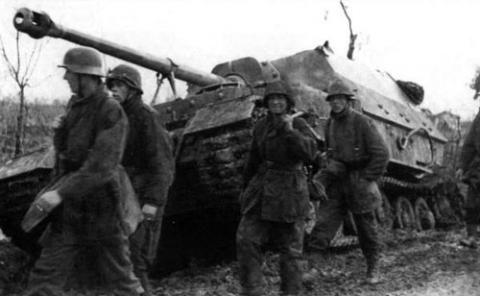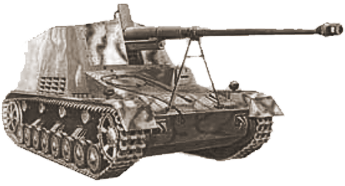April 1944 - Tarnapol

On March 4th Marshal of the Soviet Union Georgy Zhukov's 1st Ukrainian Front, including the 3rd Guards Tank Army and 4th Tank Army, attacked German Army Group South's left wing and forged numerous penetrations in German defensive lines already heavily weakened following the battle for the Korsun pocket. Zhukov's attack, though struggling at times against fierce German resistance, unhinged the German defensive front between the Fourth and First Panzer Army and penetrated deep into the German operational rear by flowing past the strongest part of the German defenses including at the city of Tarnopol.
Tarnopol was a major communications hub for not only German forces in the region but also a critically important Soviet objective for its capture would open up road and rail lines to the west. Prior to the war Tarnopol had been a thriving Polish city of 35,00-40,000 people that had been a mix of Poles and Ukrainians with a large Jewish population. Stalin had deported many of the ethnic Poles and had waged a campaign against Ukrainian Nationalists until Barbarossa when the Germans took the city and largely exterminated the Jewish population. By 1944 this battered city again found itself on the front line. Though Hitler declared Tarnapol a Fester Platz or "fortress" it was not a logical place for a defensive stand. Short of its importance as an important communications hub and minor industrial base, defending the city was made difficult in part because the surrounding terrain was largely flat and open. Thus, though the city had several notable industrial works providing some good defensive positions it was poorly situated for serving as a defensive hub and was highly vulnerable to envelopment.
In addition, a further problem for the Germans was that the practical effect of Hitler's orders designating the city a Fester Platz was to further inhibit German mobility - the one thing allowing many German units to survive the Red Army's ability to penetrate the German lines nearly at will. This was because a Fester Platz order, as per its accompanying guidelines, put German garrisons so designated, such as at Tarnopol, as well as units that came through the garrison's area, not only under the garrison's command but also meant they had to directly report to the Army Group command. Thus, the order had the effect of stripping away the ability of local divisional and corps commanders to make quick thinking decisions based upon their local knowledge of the situation on the battlefield. Of course, the latitude granted to tactical and operational level German commanders as they saw fit had been the key role in enabling an increasingly immobilized German army, in the modern sense of possessing adequate motorized transport and the fuel so needed, to fight a mobile battle by virtue of its ability to act within the decision loop of its opponent.
Nevertheless, in spite of the difficulty of their position Tarnopol's defenders had not only blocked Zhukov's initial attempt to take the city but had launched aggressive counterattacks. The 7th Panzer Division and 1st SS-Panzer Division played the lead role in attempting to blunt the Soviet offensive. However Zhukov temporarily bypassed Tarnapol and his spearheads cut not only supply lines crucial to First Panzer Army's survival but also blew open a massive hole between First Panzer Army and Fourth Panzer Army to its north. The 7th Panzer Division and 1st SS-Panzer Division were simply overwhelmed by the defensive task before them, and fought mostly for their own survival with the 7th Panzer Division actually cut in two at one point in the battle. Complicating the defensive task in the Fourth and First Panzer Army's sectors, beginning on March 5th Konev's 2nd Ukrainian Front, including the 5th Guards Tank Army and 2nd and 6th Tank Armies, also struck the overstretched German front and likewise leveraged First Panzer Army away from the Eighth Army to its south. While all this was going on the 3rd Ukrainian Front had pounded into the junction between the Eighth Army and Sixth Army further south yet - all developments auguring poorly for German chances to mass reserves needed to secure Tarnapol.
In and around Tarnopol, and though the 357th Infantry Division put up a stiff fight, Soviet close air support took a toll on German road bound units and proved so effective Soviet airpower alone had partially isolated Tarnopol as early as March 8th. The German 359th Infantry Division and 69th Infantry Division temporarily stabilized the situation in Tarnopol, where Russian forces had broken into the city on March 10th, but by March 12th-13th the 1st Ukrainian Front had enveloped the city and on March 24th completed the encirclement. An initial attempt by the 8th Panzer Division to cut through to the city failed the next day. Luftwaffe air drops were hardly effective and beginning on March 27th the Russian forces set about reducing the pocket. In spite of the enormous pressure brought to bear on the city its mixed bag of defenders held out. Finally, in April's first two weeks the 9th and 10th SS-Panzer Divisions and a kampfgruppe from the 8th Panzer Division led the attempts to break through to the city but they failed and the Russian forces eradicated the pocket by April 16, 1944.
by Steven Douglas Mercatante



Post new comment